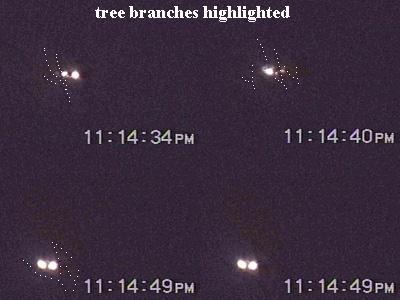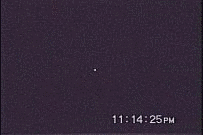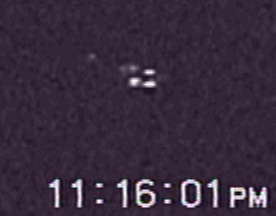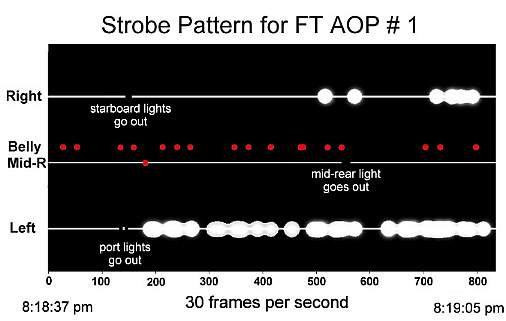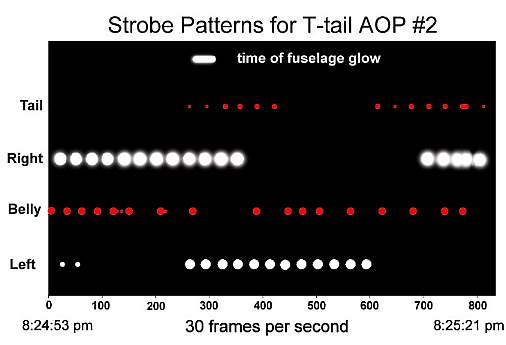Data
Location: West Searsville Rd. just south of dog-leg bend at entrance
to new housing development on hill. Panoramic view below shows landscape looking to
the east. West Searsville Rd. is visible in the foreground
(middle of picture). Pictures taken from house on hill top.
Click on panoramic view for enlargement.

|
Focus right:
Location of parked van and observation point.
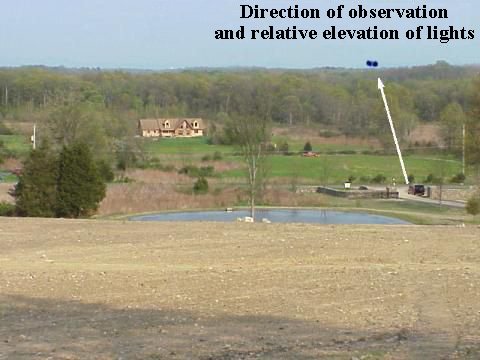
|
Two craft (AOP) were spotted that evening between
11:14 pm and 11:30 pm. One flew directly over the location where Cornet and Hartwell
parked their van. Their location and the approximate flight paths of the craft are
indicated on the composite satellite image below:
Click on image for link to high resolution satellite images.
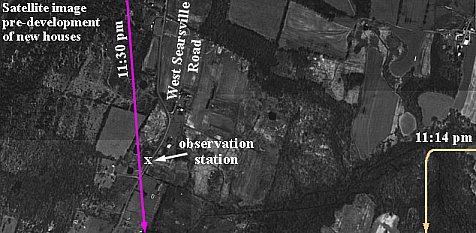
|
First
Craft
The first AOP was spotted to the east at 11:14 pm. It
brightened two lights to the extent that an aura or halo was created
around them.
Looking to east near treetop level.
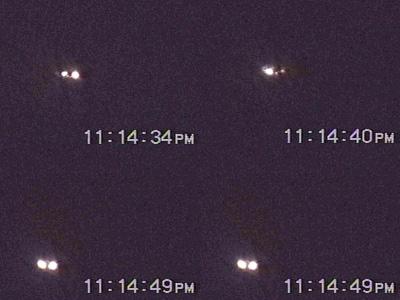
|
The craft was so low to the ground that its lights
were partially blocked by tree branches in the foreground. The tree branches are
highlighted in the image below, illuminated by the bright lights.
Animation with sound
mouse-over.
As the first craft approached the observers, it turned down the
intensity of its headlights just before turning south. As it flew south (to right)
additional lights came on along its side, giving the craft the superficial appearance of a
Boeing 747 with its two rows of windows up front.
But no Boeing 747 landed at Stewart airport that
night, and no commercial aircraft was scheduled to land within the hour of the
sighting. Another unusual aspect of this sighting is that the AOP traveled no more
than three miles during the three minutes of it captured on video. That distance
traveled and time compute to ~60 miles per hour, which is less than half the stall speed
of conventional jetliners. And its strobes appeared to fire semi-randomly,
especially the tail strobe, but this could be due to the timing of strobes and to
camcorder error (see below).
Flaring Lights and Unusual Navigation
Lights
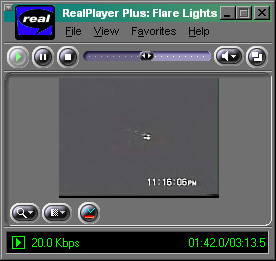


Anomalous Strobe Patterns
Presented below is a comparison of strobe intervals for the AOP and a
commercial jetliner on its way to Kennedy airport. A discussion of the differences
follows the tables.
Jetliner:
The wingtip strobes of the jetliner fired white, while the belly strobe was red
(although it appears whitish on the video). The wingtip and belly strobes
alternated, and are almost consistently separated by 37 frames on the video (the belly
strobe fired consistently 15-16 frames after the wingtip strobes). On occasion the
number of frames between strobes is lower or higher, but it cannot be determined if that
is due to camcorder error, or due to occasional variation in the firing of strobes on the
jetliner. In addition, the wingtip strobes are shielded so that they are both
visible only when the aircraft is viewed from the rear. The belly strobe was blocked
by an engine pod as the aircraft turned. On one occasion the wingtip strobes seemed
to have skipped firing, but on two other occasions the timing of those strobes coincided
with gaps between video frames, and were only partially recorded. It is suspected
that these variations are due to camcorder error or orientation/obstruction.
Additional data were analyzed in order to determine if aircraft strobes could be
missed because of camcorder error. It was discovered that jetliner strobes that
fired at 36, 37, or 38 frames had missing strobes in 30 frames-per-second video only on
occasion. However, aircraft strobes that fired every 28-29 frames missed being
recorded more frequently (e.g. three times out of 14 firings). One jetliner had
wingtip strobes that fired rapidly in a semi-random sequence (frame count between recorded
strobes: 4, 10, 15, 5, 10, 15, 15, 15, 5, 25, 6). Because a strobe firing six times
a second could be out of sync with the frames of a video, it is possible that 19 out of 31
strobes were not recorded.
AOP:
The white tail strobe and a red port strobe on the AOP are separated by 30 frames
(or an approximate multiple of 30), with the port strobe appearing white when it fired
brighter. The tail strobe occasionally appeared red when its brightness
decreased. Fluctuation in intensity could be explained by frame-strobe mismatch,
where the camcorder recorded only a portion of the strobe interval. In addition,
both the tail and port strobes skipped one to four intervals. The missing strobes
can be explained by camcorder error (the firing of strobes fell between the recorded
frames). The question then becomes: Can exceptionally long strings of unrecorded
strobes on AOP or repeating patterns of alternating strobe intervals be due only to
camcorder error? In order to understand the question, additional data need to be
considered (below).
Similar problems with inconsistent strobe patterns have been recorded for other
AOP.
In the case of the Sea Bright Black Triangle, the strobe intervals were
consistently 29 and 59, or a multiple of them (i.e. 88). What is most unusual about
this example is that there was no variation in strobe interval (e.g. mostly 29 frames but
occasionally 30 frames) as there is with conventional aircraft strobes. In this case
the pattern of strobes seems to have produced what appears to be a deliberate signal or
pattern of seven distinct strings of data. This statement is supported by the fact
that the Triangle turned on its side (belly towards camcorder) and flew without any means
of aerodynamic lift from wings for about 20 seconds (without banking or turning)! In
addition, one belly strobe alternately fired at 29 frames, then 59 frames, then 29 frames,
etc. It is highly unlikely that this variation can be totally explained by camcorder
error, which caused every third strobes not to be recorded over an interval of 87 seconds.
Three graphs showing anomalous strobe intervals for AOP.
Summary
One possible explanation for these strobe interval anomalies (which
are not due to camcorder error) is that observed patterns for conventional aircraft were
copied literally (abstract mimicry).
Whereas missing strobes on conventional aircraft are due to
orientation relative to the observer, missing strobes on AOP seem to be independent of
orientation, implying that observed variations due to obstruction or shielding were
programmed into a fake pattern. It would be like copying the engine sounds of
automobiles, and including an occasional horn sound. But the horn sound would not be
correlated with any traffic problem. The mimic would just occasionally make a horn
sound because that is what cars occasionally do.
Whereas strobes on conventional aircraft frequently illuminate
portions of the airframe, engines, wings, and control surfaces, the strobes of AOP RARELY illuminate any part of the craft's surface or structure.
On rare occasions a faint reflection off of surfaces has been recorded when the
lights become very bright, but similar bright lights on conventional aircraft would illuminate major portions of the aircraft.
Second AOP next.


Send mail to bcornet@monmouth.com
with questions or comments about this web site.
Copyright © 2000 Sirius Onion Works.
This page was last edited 09/15/2005





